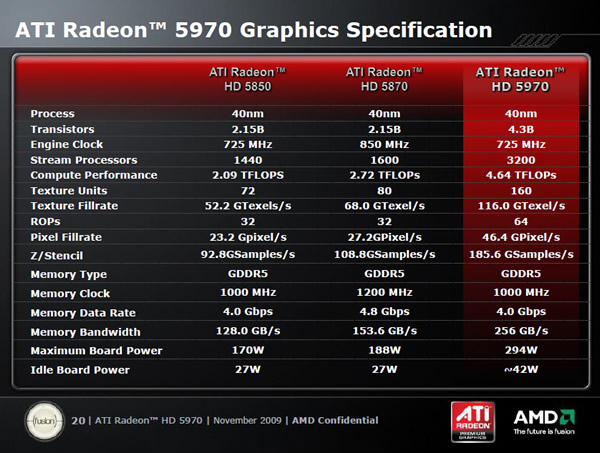The Asus HD 5970 dual core GPU is the fastest single card GPU currently in production. You can raise core voltage and it’s ready to rock the most hard core enthusiast.
INTRODUCTION
With each new generation of GPU we see better designs capable of cranking out more FPS and handling new levels of DirectX. The 58xx series from ATI/AMD is no exception. The first GPU’s we saw in that line were the 5870 and 5850 and we were thrilled with those. We didn’t expect to see a dual core 58xx GPU this soon in the cores evolution.
The last generation of dual core GPU from ATI was the 4870×2 and it was two 4870 GPU cores on one card and was keeping the X2 naming scheme. This time ATI slid one in on us and named the new dual core GPU 5970. Little discrepancies like that set us to scratching our heads and we have to dig in and find out why they deviate from an established naming scheme.
Well after digging in and looking at the cards the Asus 5970 Voltage Tweak Edition has all the hardware of two 5870 but it has the clock speed of the 5850 so ATI named it the 5970 to avoid bad press by naming it the 5870×2 which wouldn’t be correct because of the lower clock speed. Not to worry though ATI and Asus promise massive overclocking headroom so we should be able to push this card up to and beyond the stock clocks of the 5870. That or make some pretty blue smoke emanate from the chassis.

More than likely your not going to find many fancy stickers on the 5970 series cards, ATI adopts a chassis for it that incorporates holes to help heat escape. We actually like the absence of horrific monsters or heroic characters on the card. While it is the most powerful card we’ve ever seen, we don’t feel it needs a cheesy sticker to make it any more impressive. Just the mesh black chassis and size are enough to impress most people.

To show you what we mean about size we “Pack” pictured several cards, on top we have the Asus HD 5970 Voltage Tweak Edition, below that we have a Visiontek 5870, Asus GTX-285, BFG GTX-275, and on the bottom we have a Sapphire 4870. The 4870 was, by todays standards a fairly small dual slot cooler card, the Nvidia GTX lineup was a little longer, then the ATI 5870 had those cool red air intake slots and beat the Nvidia size by about a half an inch, then here comes the Asus HD 5970 and beats the 5870 by about an inch. Your going to need more than 12 inches (the card it 12 inches) to wedge this behemoth in. Most mid-towers without removable HD cages won’t accommodate this beast. Most full tower chassis will accommodate the 5970 but measure twice so you can avoid Dremmeling your chassis to fit the card. Believe us when we tell you that if any card in the world justifies buying an expensive full tower with 13 inch HD cage clearance is worth it, the Asus 5970 Voltage Tweak Edition is that card.
Specifications
Getting back to the naming scheme you can see that the Asus HD 5970 has double the hardware that the HD 5870 has but it sports the clock speed of the 5850 making it just different enough that naming it the 5870×2 would be slightly misleading. We give props to ATI for deviating from the X2 naming scheme to avoid confusion in design. This deviation leaves us watering at the mouth wondering if we are going to see a 5870×2 or even 5890×2 variant (drool).
ATI Dual Core GPU Design Philosophy
AMD’s dual-GPU graphics cards in recent times have carried a simple design:
- There are two graphics processors, each with its own memory and voltage regulation circuitry.
- One of the two gets to be connected to the displays.
- Both GPUs then have PCI-Express x16 connections to a PCI-Express bridge chip
- The PCI-Express Bridge chip broadcasts data from the host system,
- Which is directly connected over the card’s PCI-Express x16 interface
- The two GPUs have a CrossFire connection (through the bridge), and can connect to up to two more GPUs
- The card’s internal CrossFire between its GPUs is enabled by default
- The internal CrossFire is neutral to the system it is installed on so
- It doesn’t matter which make the system’s chipset is
- If you have PCI-Express x16 the card will work.
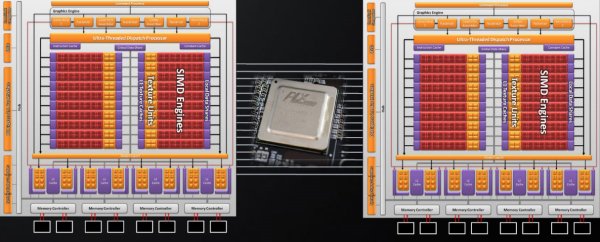
With the Radeon HD 5970, it’s no different:
- Each GPU is based on AMD’s TeraScale 2 Architecture that offers over 2 TFLOPs of processing power.
- Each GPU has 1600 stream processors, arranged into 20 SIMD engines
- Each with 16 thread processors that have 5 processing cores each.
- There are 80 texture units per GPU
- They Have 32 raster operation units
- Built on the 40 nm silicon process by TSMC
- New energy-saving performance profiles with low power draws on idle idle
- Some of the highest performance per Watt
- Each GPU uses a 256-bit wide GDDR5 memory interface, which provides 128 GB/s of memory bandwidth (256 GB/s for the entire card)
The improved PCI-Express bridge chip now supports the new PCI-Express 2.1 standard which renders the 4870×2 Sideport useless because the new PCI-E 2.0 bridge chip provides so much bandwidth. (According to AMD)
GPU Comparison Table
| GPU | GeForce GTX 280 |
Radeon HD 4870 X2 |
GeForce GTX 285 |
Radeon HD 5850 |
Radeon HD 5870 |
GeForce GTX 295 |
Radeon HD 5970 |
|---|---|---|---|---|---|---|---|
| Shader units | 240 | 2x 800 | 240 | 1440 | 1600 | 2x 240 | 2x 1600 |
| ROPs | 32 | 2x 16 | 32 | 32 | 32 | 2x 28 | 2x 32 |
| GPU | GT200 | 2x RV770 | GT200b | Cypress | Cypress | 2x GT200b | 2x Cypress |
| Transistors | 1400M | 2x 956M | 1400M | 2154M | 2154M | 2x 1400M | 2x 2154M |
| Memory Size | 1024 MB | 2x 1024 MB | 1024 MB | 1024 MB | 1024 MB | 2x 896 MB | 2x 1024 MB |
| Memory Bus Width | 512 bit | 2x 256 bit | 512 bit | 256 bit | 256 bit | 2x 448 bit | 2x 256 bit |
| Core Clock | 602 MHz | 750 MHz | 648 MHz | 725 MHz | 850 MHz | 576 MHz | 725 MHz |
| Memory Clock | 1107 MHz | 900 MHz | 1242 MHz | 1000 MHz | 1200 MHz | 999 MHz | 1000 MHz |
| Price | $329 | $429 | $340 | $299 | $399 | $500 | $599 |
Taking a look at the specs of some of the hottest GPU’s out there you can see that the Asus Radeon HD 5970 has higher specifications than it’s closest distant cousin the GTX-295. While Nvidia has a great card in the GTX-295 the 295 only has 2×240 Shader units while the HD 5970 has a whopping 2×1600. While the GTX-285 and HD 5870 both have 32 ROPs when Nvidia built the GTX-295 they backed up to 2×28 ROPs while ATI stuck with 2×32 ROPs. The Nvidia GTX-295 has 2x1400M transistors and the HD 5970 has 2x2154M transistors. Taking a look at the previous generation of ATI dual core GPU’s the 4870×2 has a puny (by comparison) 2x956M transistors and like we mentioned the 5970 has a whopping 2x2154M transistors. ATI pulled off quite the coop there, while more than doubling the number of transistors they managed to keep about the same power footprint of the 4870×2. Job well done ATI!
When Nvidia designed the GTX-295 once again they scalled back on memory and instead of having 2x1024MB memory which would be double that of the GTX-285 they cut back to 2x896MB (which is still a lot of memory). ATI went full blown and has 2x1024MB memory on the HD 5970. The HD 5970 not only has 2×1024 memory ATI chose to use 2x1024MB of GDDR5 while Nvidia stuck with GDDR3. The memory bus width is the one area where Nvidia has the edge on the HD 5970 and Nvidia has a 512 bit bus on the GTX-285 and 2x448bit on the GTX-295. ATI has chosen to keep the 256bit bus on the 5870 and 2x256bit on the HD 5970. This really makes us wonder which approach is best but we suspect that GDDR5 raw speed more than makes up for the narrower bus but by the same token we would like to see numbers with one HD 5970 with 2x256bit and one with 2x512bit memory bus width. That would be an interesting comparison.
Clock speed on the HD 5970 core is the same as the HD 5850 but in every way it has double the hardware of the HD 5870. Last generation 4890 cards we saw clock speeds peak at 850MHz and 900MHz on select factory overclocked cards. While the HD 5870 has a memory speed of 1200MHz the HD 5970 uses the memory clock speed of the HD 5850 and runs at 1000MHz.
The Sweet & Sour
According to AMD the GPU’s used in the HD 5970 are screened so that only the “Low leakage Premium ASICs” are being used. Let’s just call it fancy words for “GPU’s that overclock well”. Because if it is one thing AMD want us to do it is to overclock the HD5970.
The sweet, unlocked ATI Overdrive and voltage control on the Asus HD 5970 Voltage Tweak edition. The Sour, it’s currently priced at $599 which is reflective of being the most powerful card on the planet, and use of ultra high quality cores and components.
The Beast
Normally we just call this page Pictures & Impressions but that just didn’t seem to cover it for the Asus HD 5970. “The Beast” is a much more fitting moniker for this page. We don’t want to spill the beans (much) but the Asus 5970 Voltage Tweak Edition is indeed a beastly card in every way.

The Asus EAH5970 comes in a large (the largest we’ve ever seen) attractive box with plenty of information to help inform the consumer about the purchase.

In the bundle you’ll find:
- Graphics Card
- CrossFire Bridge
- Dirt 2 Coupon (Steam required)
- PCI-Express power adapter
- Mini-DisplayPort to DisplayPort adapter
- Documentation + Driver CDs
- DVI to HDMI Adapter
- Leather CD case
While it’s only a game coupon for Dirt 2 on Steam the inclusion of this DirectX 11 title is a welcome sight to our game poor eyes. The trend of late has been not including a game with top end GPU’s. About a year and a half ago almost every notable GPU came with a game so we hope this is a trend that will continue because face it when shelling out almost $600 for a GPU you will probably have to stay away from the game isle for a while.

Coming in at 12 inches (30cm) this is one long card. We mentioned it earlier, and you’ll hear it again, this card won’t fit most mid-tower chassis, plan on a full tower with at least 13 inch clearance to the HD cage, or a removable cage mid-tower. In this shot you get a glimpse of the mesh chassis design on the Asus HD 5970. When we first saw the card we thought that the fan was a little puny but in testing this is one of the coolest dual core GPU’s we’ve ever seen.

We were looking at the fan on the Asus EAH5970 (HD 5970) and it just looked kinda puny to us, we compared it to fans on other ATI GPU’s and it has the same dimensions but still for the worlds fastest card with dual GPU cores it looks a little small.

Peeking at the end of the card we see those cool air intake ports that make this card remind us of the early (circa 1960s, yes we are that old) Batmobile. This is about the only area that ATI could have knocked off a little of the massive length and they could have shortened the intake ports by about 1/4 inch but then the series would have different ports than the 5870 cards.

Amazingly with this massively powered GPU Asus/ATI stayed PSU compatible with the HD 5870 and you only need a good uality 550W PSU with an 8 and 6 pin PCI-E power connector. We ran the Asus HD 5970 on a high uality 550W PSU but we like headroom on PSU and decided to day to day operate it on a much larger PSU for saftey.

Backing up from the card a little and looking at the top of the card you can see the single Crossfire connector so you can crossfire this beast with a 5850 or 5870 series card. If your really insane you can Crossfire one with another HD 5970 though we suspect there isn’t a CPU out there capable of providing enough data to Crossfired 5970’s without bottlenecking the card. We seriously doubt that any CPU can fully handle a 5970 and 5870 let alone two 5970’s.

Native connectivity consists of 2 DVI and one Display port, HDMI available by adapter (included).

When you stand this card up and get an angled shot the card is so long it seems to go on forever but in reality your looking at 13 inches (30cm). If anyone gets a glimpse of this card in your rig they are going to know your a serious enthusiast.

The back of the card shows us that this is a single PCB dual core GPU and ATI has chosen to open up the back of the card where the cores are. They probably learned that lesson from the 4870×2 which typically had a full coverage back plate and tended to run hot.
TESTING & METHODOLOGY
To Test the Asus HD 5970 we did a fresh load of Windows 7 Ultimate, applied all the updates we could find, installed the latest motherboard drivers for the Asus P6T6, updated the BIOS, and loaded our test suite. We didn’t load graphic drivers because we wanted to pause to clone the HD with the fresh load of Windows 7 without graphic drivers. That way we have a complete OS load with testing suite and it’s not contaminated with GPU drivers. Should we need to switch GPU’s or run some Crossfire action later all we have to do is clone our clone and install GPU drivers and we are good to go.
We ran each test a total of 3 times and report the average here. In the case of a screenshot of a benchmark we ran the benchmark 3 times, tossed out the high and low and post the median result from the benchmark. If we got any seriously weird results we kicked out that run and redid the run. Say if we got 55FPS in two benchmark runs, then the third came in at 25FPS we kick out the 25FPS run and repeat the test. That doesn’t happen very often but anomalous runs do happen rarely.
Test Rig
| Test Rig “Quadzilla” |
|
| Case Type | Top Deck Testing Station |
| CPU | Intel Core I7 965 Extreme (3.74 GHz 1.2975 Vcore) |
| Motherboard | Asus P6T6 |
| Ram | Corsair Dominator DDR3 1866 (9-9-9-24 1.65v) 6 GB Kit |
| CPU Cooler | Thermalright Ultra 120 RT (Dual 120mm Fans) |
| Hard Drives | Patriot 128 GB SSD |
| Optical | Sony DVD R/W |
| GPU Tested |
Asus 5970 |
| Case Fans | 120mm Fan cooling the mosfet CPU area |
| Docking Stations | Thermaltake VION |
| Testing PSU | Thermaltake Toughpower 1200 Watt |
| Legacy | Floppy |
| Mouse | Razer Lachesis |
| Keyboard | Razer Lycosa |
| Gaming Ear Buds |
Razer Moray |
| Speakers | Logitech Dolby 5.1 |
| Any Attempt Copy This System Configuration May Lead to Bankruptcy | |
Synthetic Benchmarks & Games
| Synthetic Benchmarks & Games | |
| 3DMark Vantage | |
| Company of Heroes v. 1.71 | |
| Crysis v. 1.2 | |
| World in Conflict Demo | |
| FarCry 2 | |
| Warhammer 40k | |
| Crysis Warhead | |
| HawX | |
| Call Of Duty 4 | |
Please note that we might toss in a few more screenshot benchmarks, but we list the charted Games and synthetic benchmarks. So if you happen to see a screenshot of a new bench it’s us expanding on the info we have or testing a new benchmark for it’s potential for inclusion in the benchmarking suite.
World in Conflict Demo
World in Conflict is a real-time tactical video game developed by the Swedish video game company Massive Entertainment, and published by Sierra Entertainment for Windows PC. The game was released in September of 2007. The game is set in 1989 during the social, political, and economic collapse of the Soviet Union. However, the title postulates an alternate history scenario where the Soviet Union pursued a course of war to remain in power. World in Conflict has superb graphics, is extremely GPU intensive, and has built-in benchmarks. Sounds like benchmark material to us!

Lets get this out of the way right up front. We tested the Asus HD 5970 at 1680×1050 and 1920×1200 with and without AA/AF. We didn’t test it at 1280×1024 or below. Very few people still game at 1280×1024 or below and if you bought an Asus HD 5970 and game at 1280×1024 please send us your address so we can send someone by to A. Confiscate the card, B. Slap you in the back of the head.
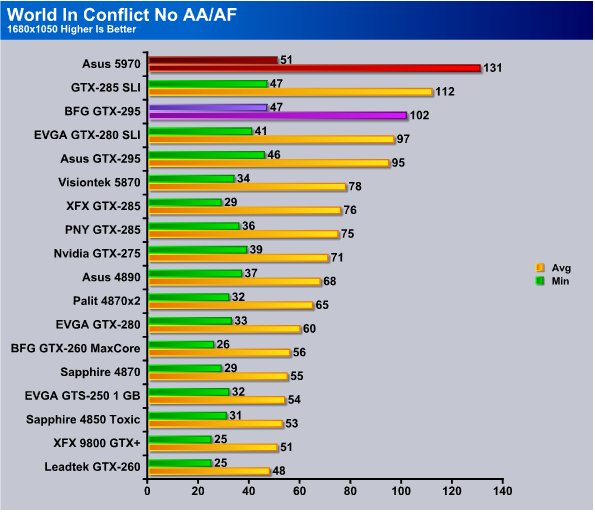
We have a lot of data on World In Conflict so we went ahead and benched it because it still stresses a lot of GPU’s. The Asus HD 5970 ate WiC and indeed most games for lunch and had room left over for dessert. For your convenience we have highlighted the GTX-295, one of the two, whichever came closest to the Asus 5970. Minimum FPS the 295 came close to the HD 5970 but in average FPS we got 29FPS more from the Asus 5970.
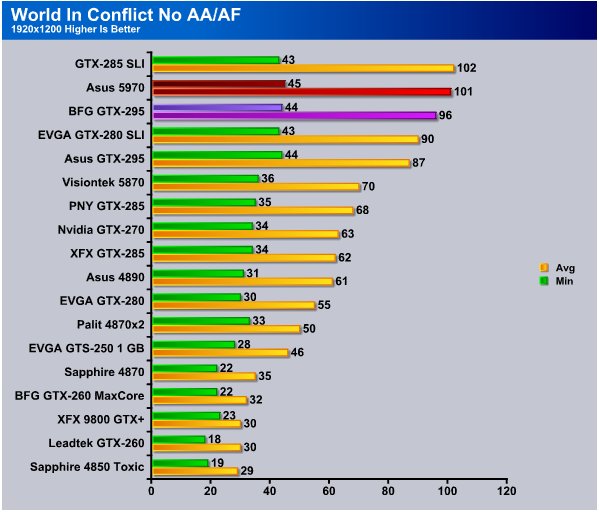
At 1920×1200 the GTX-285 SLI setup managed to squeeze the Asus 5970 out by 1 FPS but the Asus 5970 beat that dual card arrangement in minimum FPS by 2 FPS. The GTX-295 ran one FPS behind the 5970 in Minimum FPS and 5FPS slower in average FPS.

We got another close result at 1680×1050 with AA/AF turned on and the Asus 5970 beat the 295 by 2 FPS Minimum and 7FPS average. One of the reasons why we still bench WiC is that it isn’t particularly well optimized for either Nvidia or ATI, you’ll see greater differences in some of the newer games.
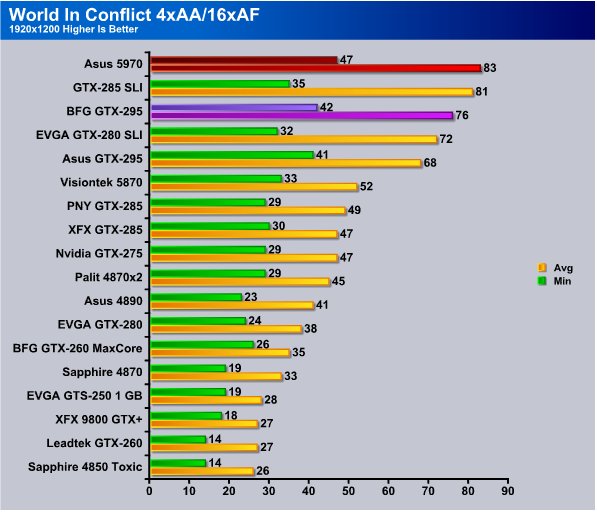
By now we are getting the idea that the Asus HD 5970 is comfortable on top the charts and intends to stay there. While dual card setups are somewhat comparable we intend to focus on dual core GPU’s for the most part.
The two dual core GPU’s have been pretty close in WiC and the Asus HD 5970 comes out 5FPS ahead of the GTX-295 in minimum FPS and 7FPS in average FPS.
Crysis v. 1.21
Crysis is the most highly anticipated game to hit the market in the last several years. Crysis is based on the CryENGINE™ 2 developed by Crytek. The CryENGINE™ 2 offers real time editing, bump mapping, dynamic lights, network system, integrated physics system, shaders, shadows, and a dynamic music system, just to name a few of the state-of-the-art features that are incorporated into Crysis. As one might expect with this number of features, the game is extremely demanding of system resources, especially the GPU. We expect Crysis to be a primary gaming benchmark for many years to come.

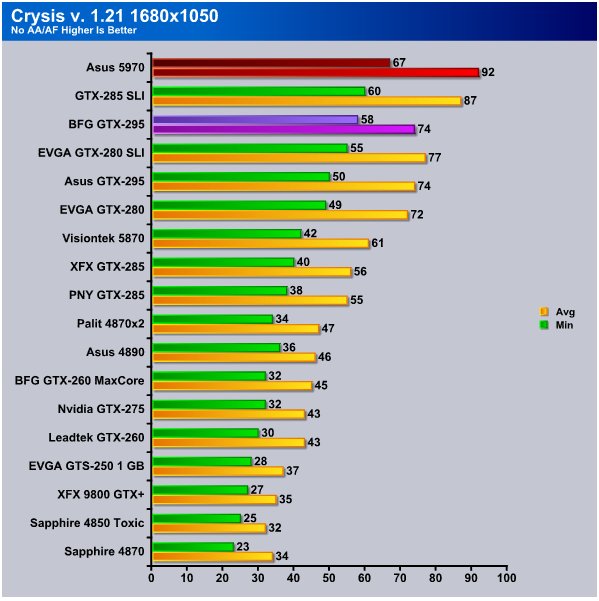
Crysis see’s the Asus HD 5970 topping out the charts again and it leads the GTX-295 by 9FPS minimum FPS and 18FPS on the average side of things.
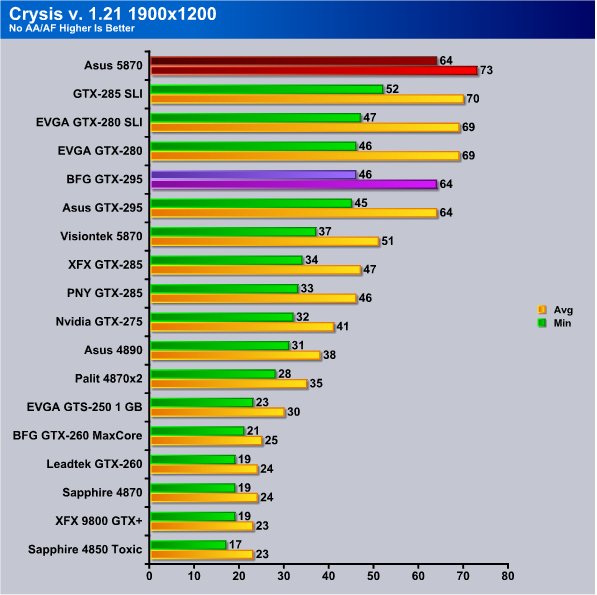
Moving to 1920×1200 still sees the Asus HD 5970 running at more than twice what is required for rock solid game play. The GTX-295 fell behind the 5970 by 18FPS minimum and 9FPS average. The Asus HD 5970 is looking strong and we hope this speed is enough to keep it running good when we apply AA/AF in this GPU crushing game.
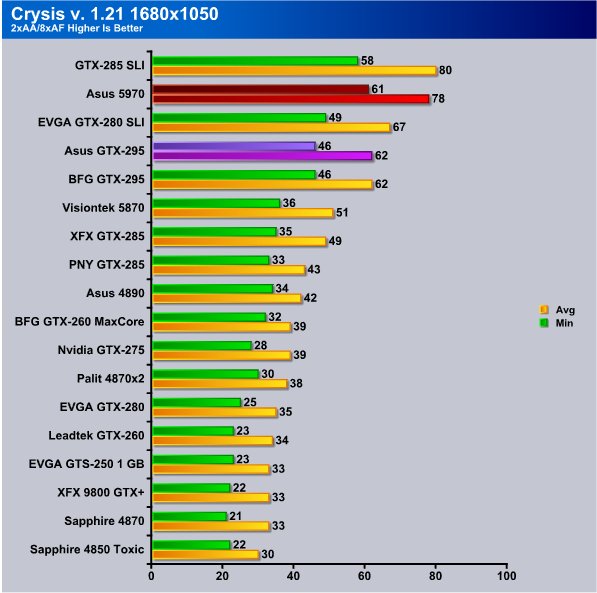
Kicking AA/AF on at 1680×1050 the Asus HD 5970 is still running strong at hits 61FPS minimum and 78FPS average, it keeps a 15FPS lead on the GTX-295 in minimum FPS and 16FPS in average FPS.
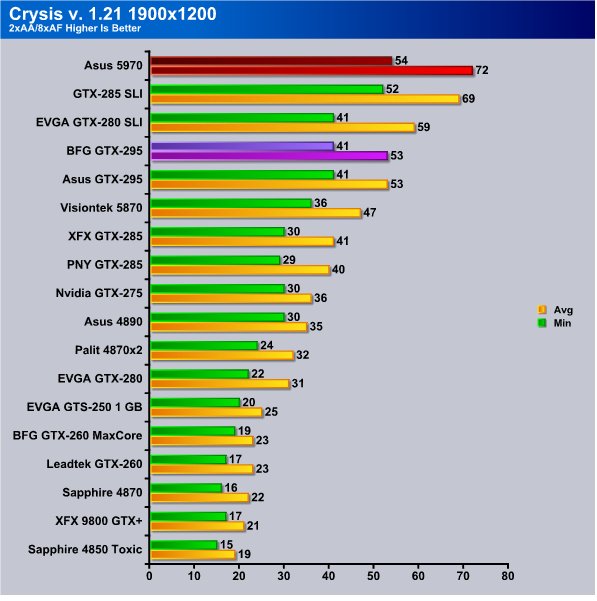
At the highest resolution we tested 1900×1200 the Asus HD 5970 is still running strong and turns in a blazing 54FPS which is 13FPS ahead of the mighty GTX-295 and a whopping 72FPS average which is 19FPS ahead of the GTX-295.
Speeds like this leave a guy wondering where GPU design will go next. Will we need motorcycle straps to hold the next generation of GPU in the chassis. Will light escape from the GPU’s or will they look like small black holes emanating only darkness and raw speed?
CRYSIS WARHEAD
Crysis Warhead is the much anticipated sequel of Crysis, featuring an updated CryENGINE™ 2 with better optimization. It was one of the most anticipated titles of 2008.


Typically Warhead is a little harder on GPU’s than Crysis even though Warhead is supposed to have a more optimized CryEngine 2. If the engine is more optimized then they either stuck in more eye candy or the game itself is less optimized because frame rates have always been a little lower in Crysis Warhead.
The Asus HD 4970 did pretty well in this graphic rich game and turned in a 44FPS minimum, the GTX-295 managed to edge out ahead of it in minimum FPS and beat it by 3FPS but in average FPS where the lions share of the game will operate the Asus HD 5970 came out ahead by 20FPS.
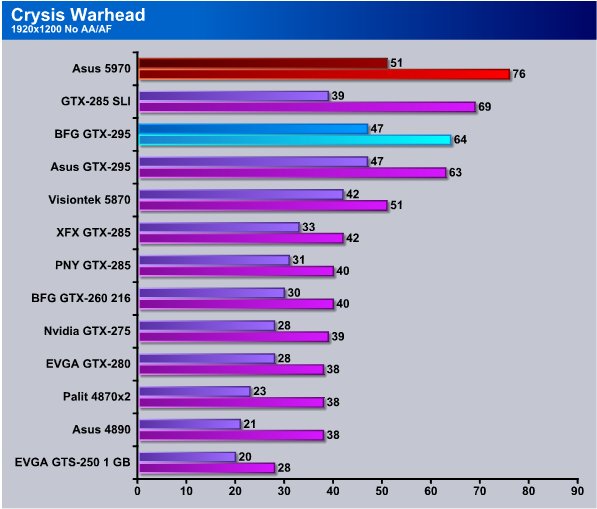
We might have been a little CPU bottlenecked at 1680×1050 because we got better FPS from the Asus HD 5970 on minimum FPS at this higher resolution. The 5970 came in at 51FPS minimum while the GTX-295 came in at 47FPS which is 4FPS less. Average frame rate on the 5970 hit 76FPS and that is 12 FPS faster than the GTX-295.
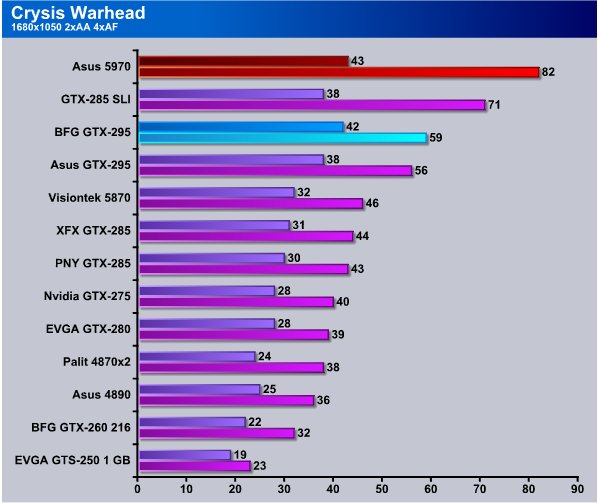
Moving to 1680×1050 with 2xAA/4xAF the Asus HD 5970 hits 43FPS minimum and is just one FPS ahead of the GTX-295. When the 5970 hits average FPS it comes in at 82FPS and that is an amazing 23FPS ahead of the GTX-295.
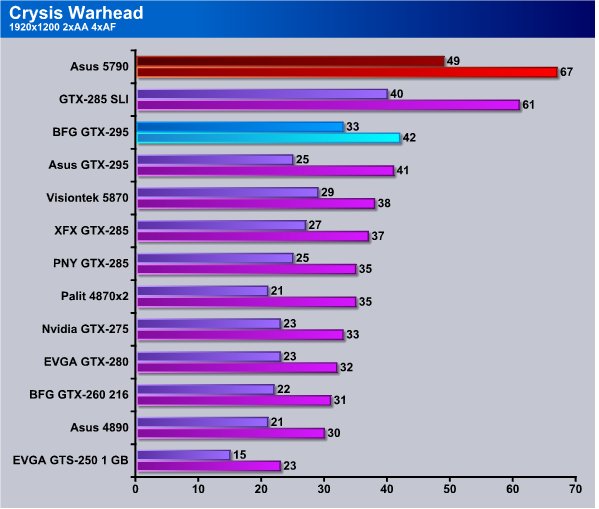
The highest resolution we tested was 1920×1200 and the Asus HD 5970 is still running strong with 49FPS minimum or 16FPS ahead of the GTX-295 which was a mere 3FPS away from what we consider minimum playable frame rates (30FPS to maintain smooth video). Average frame rates on the 5970 ran 67FPS and that’s 25FPS ahead of the GTX-295.
We thought you should know that we have checked Federal law and while marriage to the Asus 5970 isn’t expressly forbidden we suspect that you will have a hard time finding a Minister to perform the ceremony. Who knows though throw a dress on the 5970 a little makeup, uhh never mind.
Far Cry 2
Far Cry 2, released in October 2008 by Ubisoft, was one of the most anticipated titles of the year. It’s an engaging state-of-the-art First Person Shooter set in an un-named African country. Caught between two rival factions, you’re sent to take out “The Jackal”. Far Cry2 ships with a full featured benchmark utility and it is one of the most well designed, well thought out game benchmarks we’ve ever seen. One big difference between this benchmark and others is that it leaves the game’s AI (Artificial Intelligence) running while the benchmark is being performed.
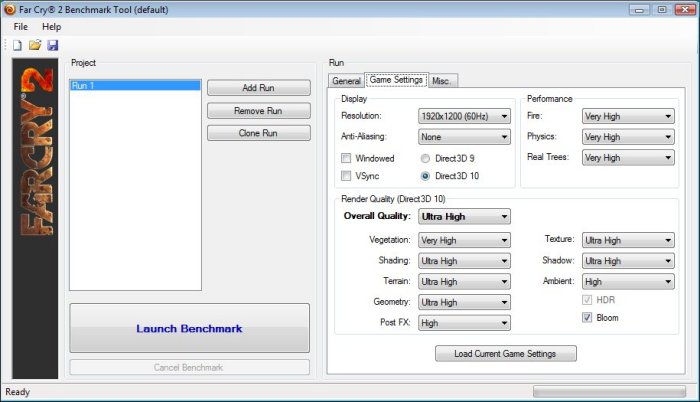
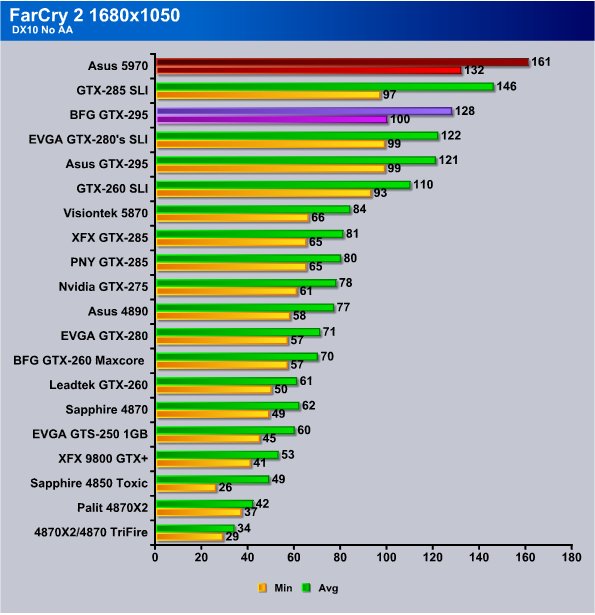
Far Cry 2 was heavily optimized for Nvidia GPU’s at launch and it is one of Nvidia’s flagship SLI games, even given those conditions the Asus HD 5970 outperforms the GTX-295 by quite a large margin. Minimum FPS the Asus 5970 comes in 32FPS faster and average FPS 33FPS faster. The lead that the Asus 5970 has on the GTX-295 is enough, by itself, to play the game with rock solid graphics.
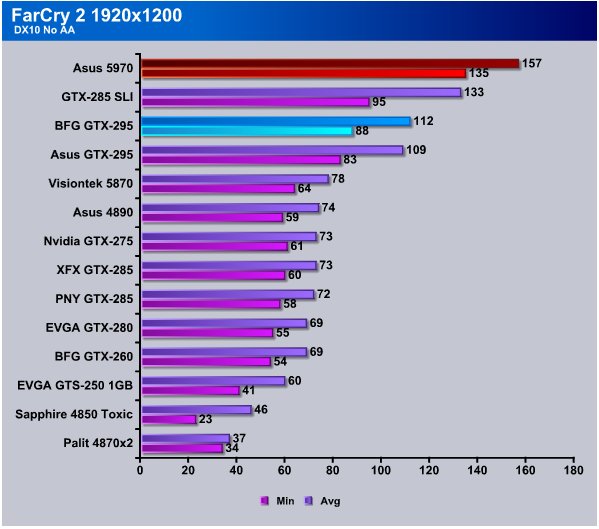
Moving to 1920×1200 the Asus HD 5970 is still eating Far Cry 2 for lunch and churns out 135 FPS minimum and 157FPS average. It managed to increase minimum FPS by a couple of Frames from the lower resolution we tested.
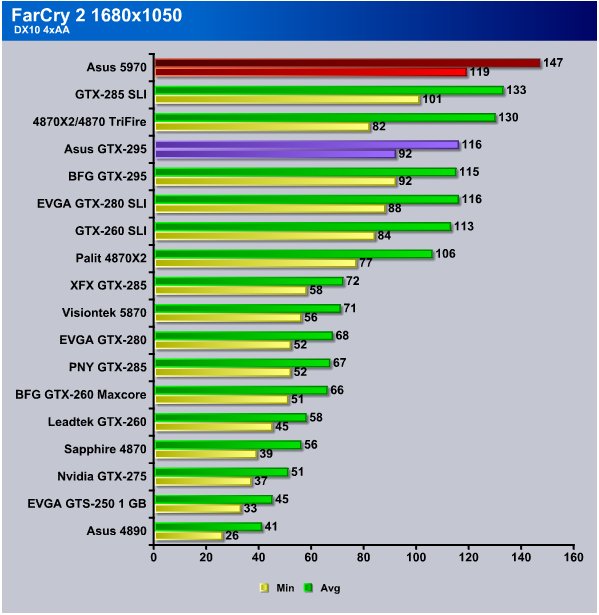
Turning AA/AF on at 1680×1050 the Asus HD 5970 barely even slows down and turns in 119FPS minimum 17FPS ahead of the GTX-295. Average FPS it comes out at 147FPS or 31FPS faster than the GTX-295. Given that it’s early in driver development for the 5970 things can only get better for it as time progresses but even with early drivers so far it’s putting a whipping on every other dual core card we’ve seen.
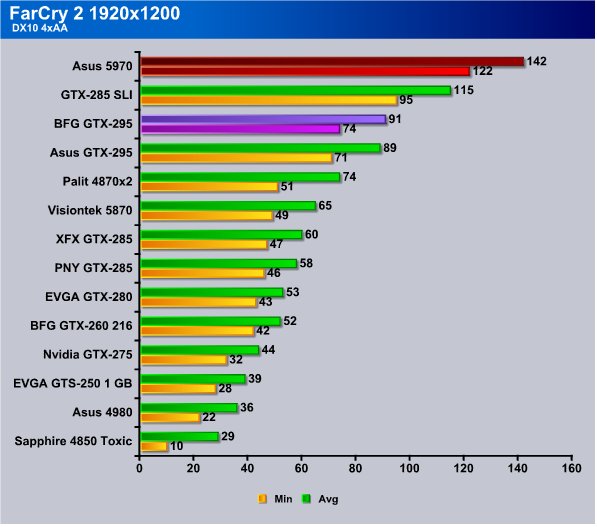
The highest resolution we tested see’s the Asus HD 5970 churning out 122FPS minimum and amazingly that’s a couple of FPS faster than at 1680×1050, this card likes high resolution and AA/AF! Average FPS the 5970 hits 142 FPS and again amazingly that’s 51FPS faster than the GTX-295.
Dawn of War: Warhammer 40,000
Developed by award winning Relic Entertainment, Dawn of War II ushers in a new chapter in the acclaimed Real-Time Strategy series – taking players to the brutal frontlines of war to lead an elite strike force on a mission to save the galaxy.
It is the 41st Millennium in Sub-Sector Aurelia – a cluster of worlds on the edge of the Galaxy – and a battle of epic proportions is about to begin. Ancient races will clash across the planets that dot this section of space, battling for the greatest of stakes – not only the claim to the land and its bounty – but the fate of each race.
With a focus on fast-action RTS game play, Dawn of War II brings to life the science fiction universe of Warhammer 40,000 like never before. Experience the intimate brutality of battle as you play through the epic campaign. Clash with enemies on battlefields ablaze with visceral hand-to-hand and ranged combat. Lead and develop your squads into the most battle hardened elite strike force in the Galaxy.
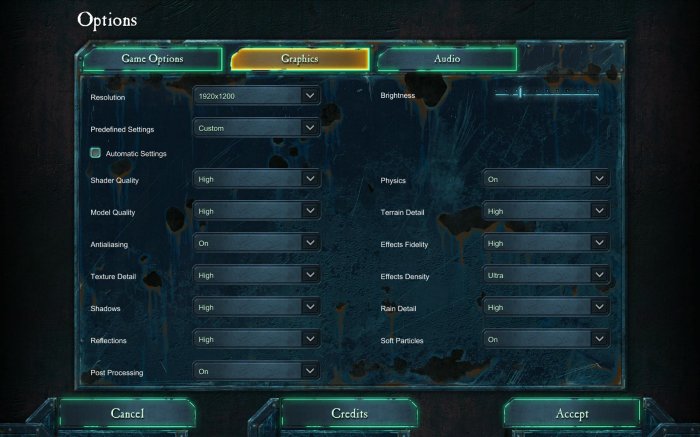

Warhammer tends to be a little CPU bottlenecked at lower resolutions but it scales well with different GPU’s. We don’t use Warhammer a lot but we like to toss in the occasional unexpected game to keep things fresh. One of the aspects of reviewing that we have to face is that if you don’t do some switch up on your gaming suite then GPU manufacturers can optimize for the gaming suite and skew the benchmark numbers. Think about it, do you honestly think that there’s a current GPU or driver out there that isn’t highly optimized for say PCMark Vantage?
The Asus HD 5970 turned in 131FPS minimum which was 35FPS ahead of the GTX-295 and average FPS it maintains it’s lead on the GTX-295 by 24FPS. With this much testing showing the Asus HD 5970 topping the charts we could stop right here and make our call on the Asus HD 5970 but that would be a waste of some laboriously built charts. (We know you love charts as much as we do)
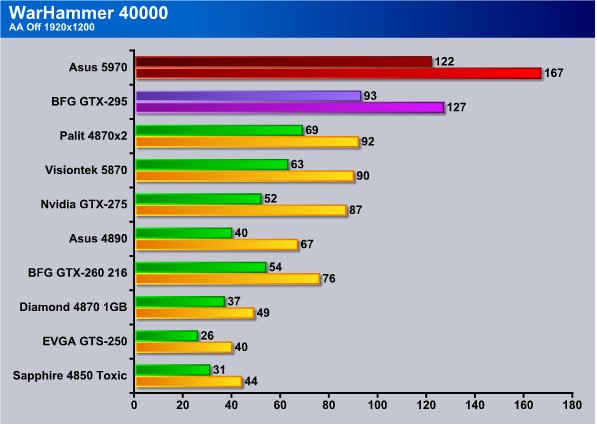
At 1920×1200 no AA/AF the Asus HD 5970 is still sneering at WarHammer 40,000 and if we listen closely you can almost hear the 5970 chanting “Is that all you’ve got”. Or it might just be a rap song wafting it’s way across from an adjacent building it’s hard to tell after long hours of benching and charting. We’ve heard rumors of reviewers hallucinating by this stage but we’re not buying into that rumor. Just because your seeing unicorns and dancing trolls doesn’t mean your hallucinating.
The Asus HD 5970 turns in 122FPS minimum or 19FPS ahead of the GTX-295 and on average FPS it hits 167FPS or 40FPS ahead of the GTX-295 and we find ourselves wondering if there is any game that this card will stall on.
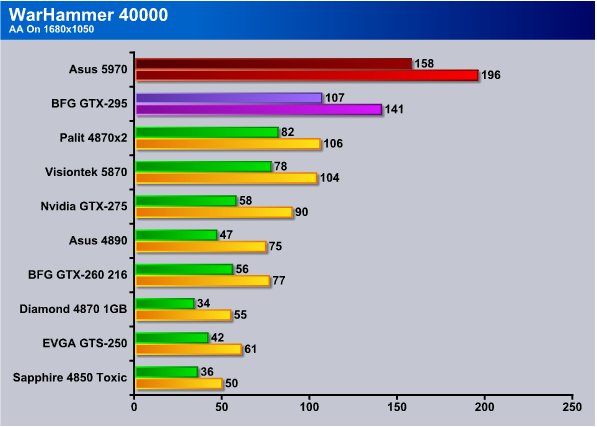
At 1680×1050 with AA/AF turned on the Asus HD 5970 ran faster than it did at the same resolution without AA/AF which means one of two things, the game is slightly bottlenecked by the CPU at the lower resolution or the card was built with AA/AF in mind. No matter the cause with FPS like this you might need to wear sunglasses to keep your eyes from popping out of your head.
Minimum FPS the Asus HD 5970 hit 158FPS and amazing 51FPS ahead of the GTX-285, on average FPS it came out 55FPS ahead of the former King of GPU’s.
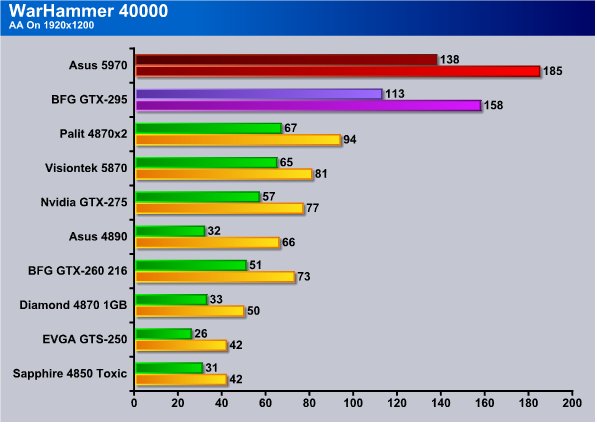
The highest resolution tested with AA/AF on doesn;t slow the Asus HD 5970 down but instead it picked up considerable FPS from tessting with AA/AF off at the same resolution. We don’t particularly like it when that happens for one simple reason. We have to repeat the test several extra times to confirm the results. We love the higher FPS but the extra testing can get on your nerves a little.
The Asus HD 5970 hit 138FPS average or about 25FPS faster than the GTX-295 and on average FPS it hit 185FPS or 27FPS faster than the GTX-295.
HawX
The story begins in the year 2012. As the era of the nation–state draws quickly to a close, the rules of warfare evolve even more rapidly. More and more nations become increasingly dependent on private military companies (PMCs), elite mercenaries with a lax view of the law. The Reykjavik Accords further legitimize their existence by authorizing their right to serve in every aspect of military operations. While the benefits of such PMCs are apparent, growing concerns surrounding giving them too much power begin to mount.
Tom Clancy‘s HAWX is the first air combat game set in the world–renowned Tom Clancy‘s video game universe. Cutting–edge technology, devastating firepower, and intense dogfights bestow this new title a deserving place in the prestigious Tom Clancy franchise. Soon, flying at Mach 3 becomes a right, not a privilege.
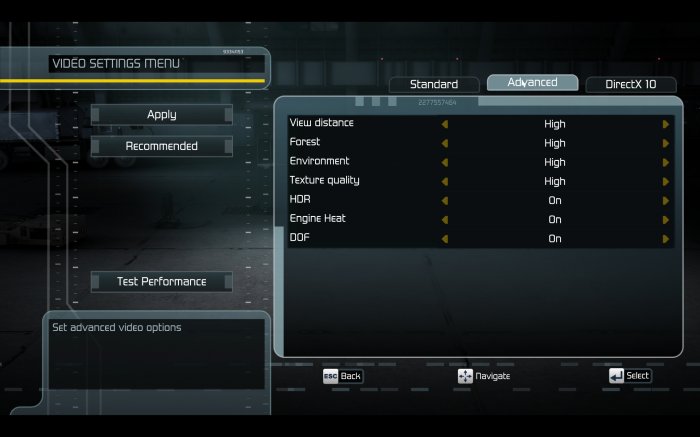
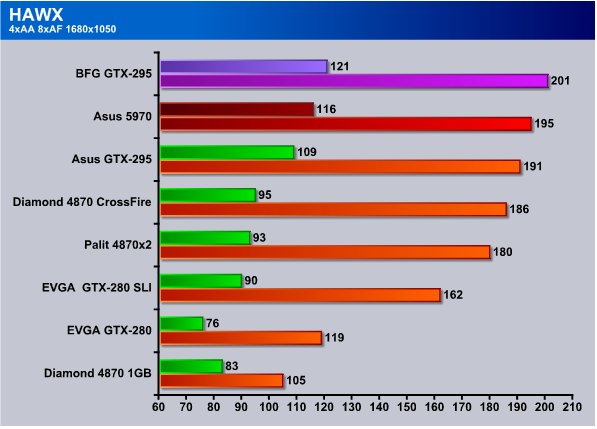
HawX is one of those games (And Call Of Duty 4) that you don’t really need to test without AA/AF because it’s well optimized. With FPS running above 100FPS Minimum testing without AA/AF is a little redundant but we wanted to present as large a sample of games as possible on this epic GPU.
In HawX it looks like the GTX-295 was tired of taking a beating and came out slightly ahead of the Asus HD 5970 but by the same token the second GTX-295 came out slower so it’s a hard call on this one.
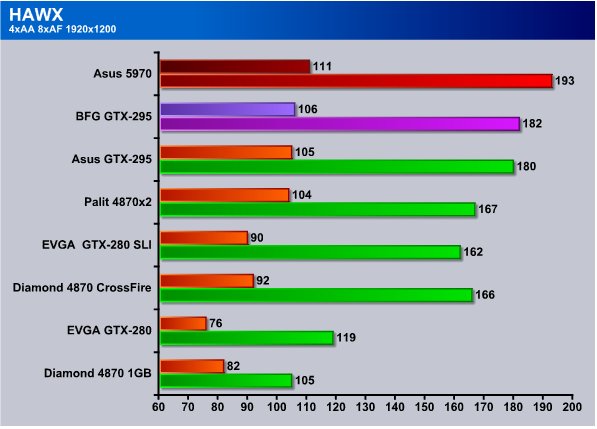
Hitting the highest resolution with AA/AF the Asus HD 5970 woke up and jumped back into the lead of the Dual GPU class. We’ve seen it in several charts and the Asus HD 5970 holds it’s own well when the eye candy is cranked up.
CoD4
Call of Duty 4: Modern Warfare, the new action thriller from the award-winning team at Infinity Ward, the creators of the Call of Duty series, delivers the most intense and cinematic action experience ever.
Armed with an arsenal of advanced and powerful modern-day firepower, players are transported to treacherous hotspots around the globe to take on a rogue enemy group threatening the world. As both a U.S. Marine and British S.A.S. soldier fighting through an unfolding story full of twists and turns, players use sophisticated technology, superior firepower, and coordinated land and air strikes on a battlefield where speed, accuracy, and communication are essential to victory.
The epic title also delivers an added depth of multiplayer action providing online fans an all-new community of persistence, addictive, and customizable gameplay.
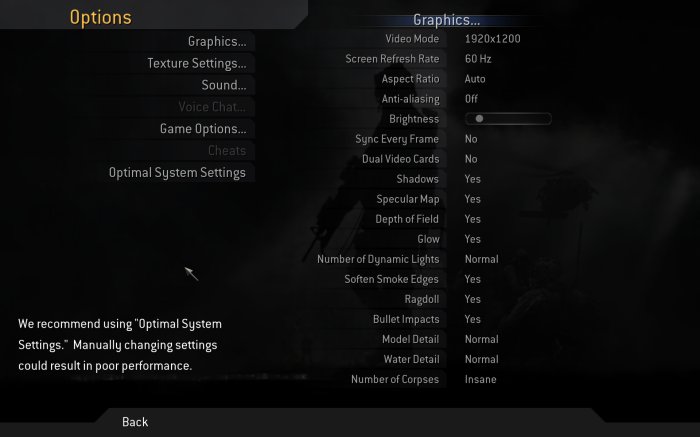
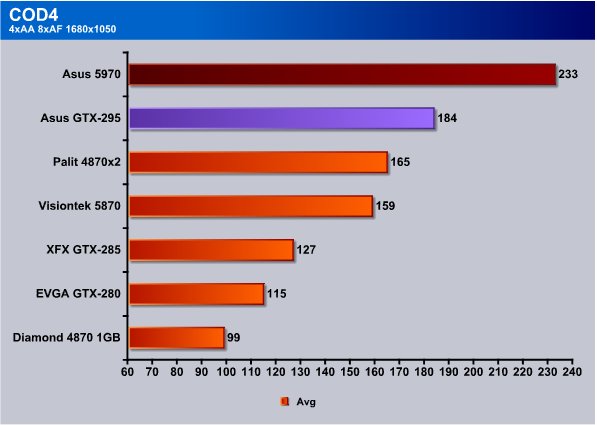
In COD4 we are just reporting average FPS because run to benchmark run the average FPS stayed pretty steady but the minimum FPS were a little to spotty for our liking.
The Asus HD 5970 turned in an eye watering 233FPS average and topped the GTX-295 by 49FPS. Even throwing in the oddball benchmarks we can’t find any chinks in the armor of the Asus HD 5970.
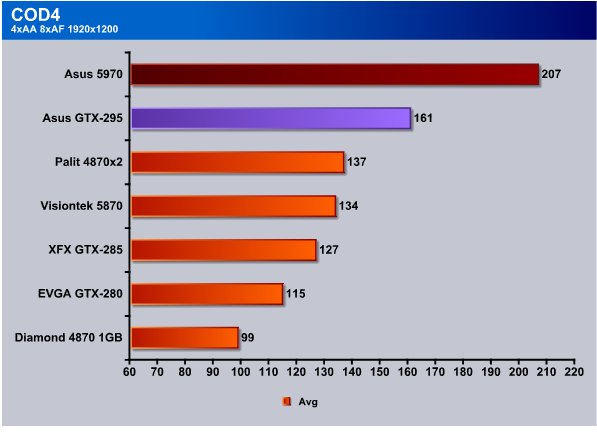
When we hit 1920×1200 4xAA/8xAF we were about ready to marry the Asus HD 5970 but like we mentioned earlier we couldn’t find a minister to perform the ceremony. Well there was one guy but we suspect that he was one of those internet ordained ministers.
The Asus HD 5970 hit’s 207FPS average in COD4 and tops the GTX-295 by 56FPS or nearly double what it takes to maintain eye pleasing graphics.
Company Of Heroes v. 1.71

We broke out one of our old favorites, Company of Heroes because we have a lot of data on it. As you can see though the Asus HD 5970 is producing five times the minimum FPS needed for solid graphics and turned in 151FPS in this oldie but goodie. Average FPS ran at 389FPS. The GTX-295 was turning in massive FPS but still it came in behind the Asus 5970. If you notice though the Asus HD 5970 was turning in double the FPS of the GTX-295 on minimum FPS so we though it worthwhile to toss in CoH.
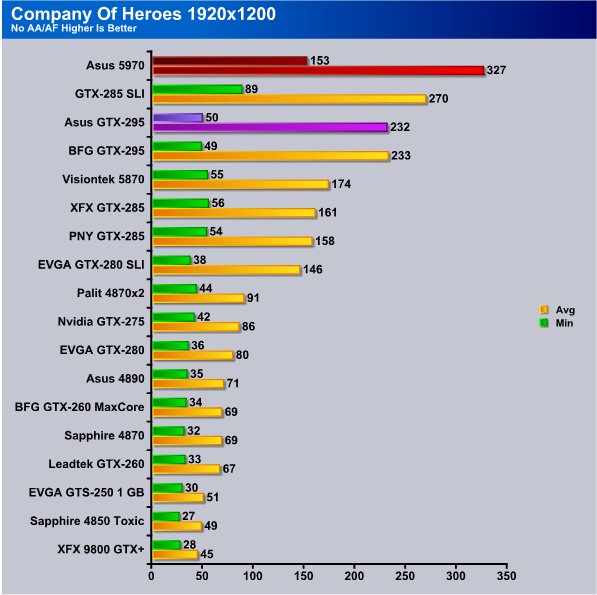
By this point we were pretty amazed with he Asus HD 5970 and it was still turning in five times the playable frame rate and three times what the GTX-295 was doing for minimum FPS. Of course both cards were well into playable frames but three times the minimum FPS is pretty impressive.

Turning on AA/AF isn’t really hurting performance much we dropped 10FPS minimum from the same resolution without AA/AF but when your topping 140FPS with AA/AF 10FPS in nothing to the eye. Here again we see the HD 5970 putting a serious whipping on the GTX-295 and without going into details the Asus HD 5970 is more than comfortably in the lead.
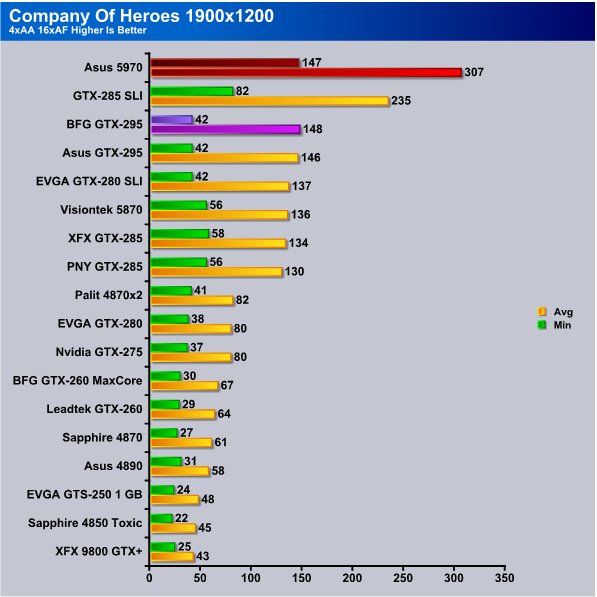
Here at 1920×1200 with AA/AF the Asus HD 5970 managed to pick up a few FPS on the minimum FPS and turned in 307 FPS average. More than triple the FPS of the GTX-295 minimum FPS and more than double the average FPS. This should give you some idea of why we like to throw a curve at the benchmark suite occasionally. We often perform extra testing without discovering any more relevant data but once in a while something like this pops up and smacks us on the forehead.
3DMark Vantage
For complete information on 3DMark Vantage Please follow this Link:
www.futuremark.com/benchmarks/3dmarkvantage/features/
The newest video benchmark from the gang at Futuremark. This utility is still a synthetic benchmark, but one that more closely reflects real world gaming performance. While it is not a perfect replacement for actual game benchmarks, it has its uses. We tested our cards at the ‘Performance’ setting.
Currently, there is a lot of controversy surrounding NVIDIA’s use of a PhysX driver for its 9800 GTX and GTX 200 series cards, thereby putting the ATI brand at a disadvantage. Whereby installing the PyhsX driver, 3DMark Vantage uses the GPU to perform PhysX calculations during a CPU test, and this is where things get a bit gray. If you look at the Driver Approval Policy for 3DMark Vantage it states; “Based on the specification and design of the CPU tests, GPU make, type or driver version may not have a significant effect on the results of either of the CPU tests as indicated in Section 7.3 of the 3DMark Vantage specification and white paper.” Did NVIDIA cheat by having the GPU handle the PhysX calculations or are they perfectly within their right since they own Ageia and all their IP? I think this point will quickly become moot once Futuremark releases an update to the test.
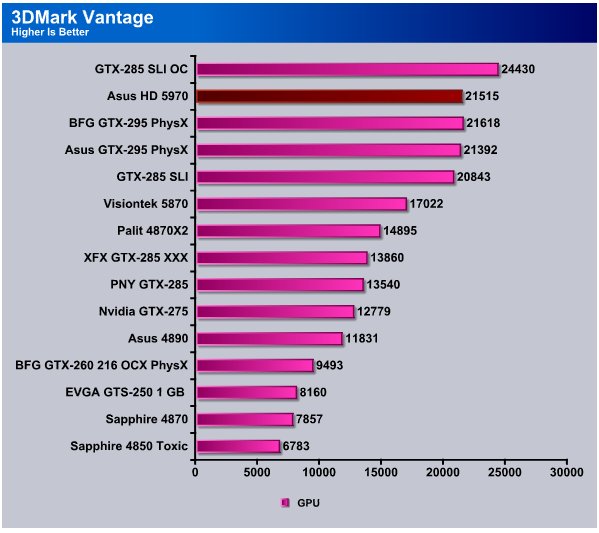
The Asus HD 5970, without the benefit of PhysX, is coming in at 21,515 on 3DMark Vantage. The scores we have for the GTX-295 lineup are with PhysX and even with the GPU inflating the CPU score the Asus HD 5970 is more than a match for them. Turn PhysX off and the GTX-295 cards would fall far short of this score. Typically PhysX can add 3 – 4,000 poins to the overall score. Single card, dual core GPU hitting above 21k without PhysX this is a first for us and we continue to be more than impressed with the Asus HD 5970.
TEMPERATURES
To get our temperature reading, we ran FurMark looping for 10 minutes to get the load temperature. To get the idle temp we let the machine idle at the desktop for 30 minutes with no background tasks that would drive the temperature up. Please note that this is on an open test station, so your chassis and cooling will affect the temps your seeing.
| GPU Temperatures | |||
| Idle | Load | ||
| 35°C | 89° C | ||
We left the fan on the Asus EAH5790 on auto and we saw really reasonable temperatures from the card. Compared to it’s older brother the ATI 4870×2 these temperatures are more than reasonable. Incidentally we used Furmark to heat the GPU for 20 minutes before taking the reading. It’s a little unrealistic in that it is designed to generate maximum heat and the likelihood of seeing this type result in real life is minimal. Still it represents worst case heat so we find it useful.
POWER CONSUMPTION
To get our power consumption numbers we plugged in out Kill A Watt power measurement device and took the Idle reading at the desktop during our temperature readings. We left it at the desktop for about 15 minutes and took the idle reading. Then, during the 30 minute loop of 3DMark Vantage we watched for the peak power consumption, then recorded the highest usage.
| GPU Power Consumption | |||
| GPU | Idle | Load | |
| Asus EAH5970 | 182 Watts | 412 Watts | |
| Gigabyte 4890 OC | 239 Watts | 358 Watts | |
| Asus EAH4770 | 131 Watts | 205 Watts | |
| BFG GTX-275 OC | 216 Watts | 369 Watts | |
| Nvidia GTX-275 Reference | 217 Watts | 367 Watts | |
| Asus HD 4890 Voltage Tweak Edition | 241 Watts | 359 Watts | |
| EVGA GTS-250 1 GB Superclocked | 192 Watts | 283 Watts | |
| XFX GTX-285 XXX | 215 Watts | 369 Watts | |
| BFG GTX-295 | 238 Watts | 450 Watts | |
| Asus GTX-295 | 240 Watts | 451 Watts | |
| EVGA GTX-280 | 217 Watts | 345 Watts | |
| EVGA GTX-280 SLI | 239 Watts | 515 Watts | |
| Sapphire Toxic HD 4850 | 183 Watts | 275 Watts | |
| Sapphire HD 4870 | 207 Watts | 298 Watts | |
| Palit HD 4870×2 | 267 Watts | 447 Watts | |
| Total System Power Consumption | |||
Looking at power consumption from a last generation to this generation perspective the Asus EAH5970 is looking pretty good. At an idle it consumed (total system) 182 Watts while in the same rig the 4870×2 consumed 267 Watts. The only difference in the systems was the GPU so the EAH5970 is consuming 85 Watts less at an idle. Fully loaded with Furmark 20 minutes into the temperature test we took the load reading and got 412 Watts, the older 4870×2 consumed 447 so we are seeing a savings of 35 Watts.
Taking into consideration that the Asus EAH5970 is considerably more powerful than the 4870×2 yet manages to use less power we would have to give it a thumbs up on power consumption.
OVERCLOCKING
Lets take a look at a GPU-Z shot of the Asus EAH5970 before we get into the serious overclocking.
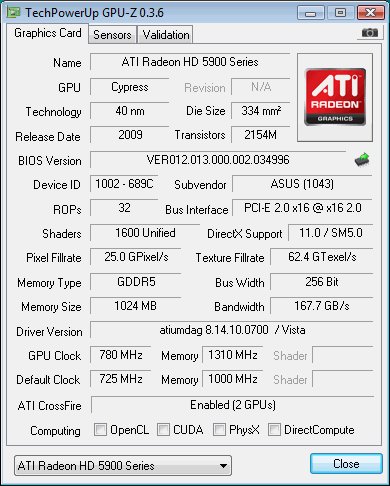
In this shot we are using stock voltage on the Voltage Tweak edition EAH5970. Stock clocks run at 725MHz on the core and we managed to get 780MHz on stock voltage. We had it at 790MHz for a while but after about 20 minutes we got an artifact and backed up to 780 which tested clean for 30 minutes.
This is a Voltage Tweak Edition EAH5970 so what fun is just looking at what we can get with stock voltage. Before we go any farther we aren’t saying this is a speed we would run the Voltage Tweak Edition EAH5970 at 24/7, we aren’t even saying that this is a safe speed and voltage for suicide runs. Keep in mind this is a $599 video card so some caution is well advised. We on the other hand are somewhat insane (legally) and pushed the envelope.
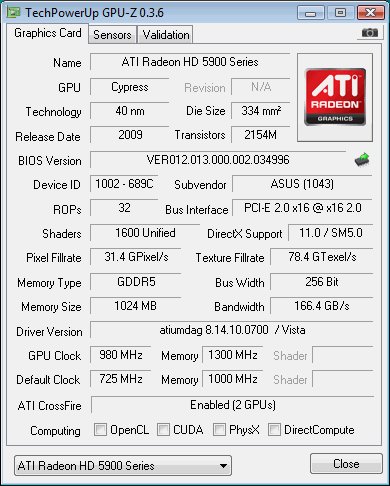
ATI and Asus promised us massive overclocking headroom. They delivered on that promise quite well. Using 1.339v we got 980MHz on the core and pushed the memory up to 1300. We would consider this an insane overclock and not safe for the normal 1.05v core used on the Asus Voltage Tweak Edition.
We did manage to hit 850MHz with a fairly reasonable 1.13v and it ran for bettr than an hour with no artifacts. Beyond 850MHz we had to pour on voltage to get any gains. Up around 900MHz we had to feed the GPU more than 1.25v and at 980MHz it took 1.339v. With a well vented chassis we would be comfortable with 850MHz and 1.13v but exceeding 1.15v for extended periods not so much.
Now how does Asus provide for adding voltage?
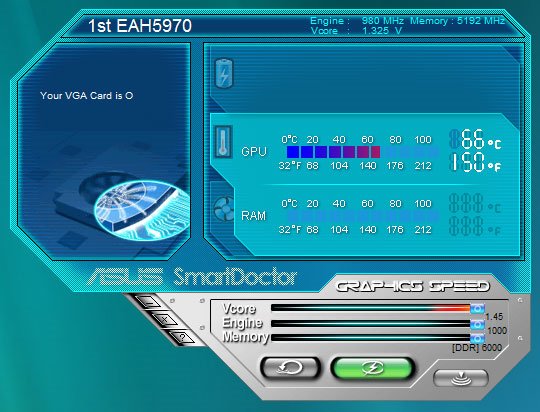
They included the voltage adjustment in Asus SmartDoctor. We slid the slider up as far as it would go but never tested at this voltage. The 1.45v available on Asus Smart Doctor would quickly toast an air cooled GPU and we suspect make short work of a water cooled GPU. We are however running at 980MHz and SmartDoctor is showing 1.325v but later we had to up voltage to 1.339v for complete stability.
Keep in mind this is an insane OC for a very short period only. These kinds of voltage can easily kill your GPU in just a few days and we don’t want to hear, “I did what you did and mine died.” Even the massive overclocking headroom only got us about 5 – 8 FPS increase and we were already running at fantastic FPS anyway so there’s not much point in OCing except for bragging rights and benchmark scores.
CONCLUSION
We were highly impressed with the Asus EAH5970 Voltage tweak Edition. We were very impressed without even overclocking or adding voltage. Having the ability to add a touch of voltage just sweetens the deal. The DirectX 11 benchmarks and games we’ve seen so far take graphics to the next level and the Asus EAH5970 is ready for that evolution in graphics.
Tossing Dirt 2 a soon to be released game title into the bundle just made things look even brighter. We miss the days of major GPU’s being bundled with a game title and long for the return to selected models having a game bundled. Asus took care of that longing with Dirt 2 and we’d like to thank the for caring enough to toss a game on the stack.
Performance on the Asus EAH5970 Voltage Tweak Edition was off the hook. We liked almost everything about the Asus 5970 except the price, $599 at the time of posting and that’s a little rich for most peoples blood. However if you have the extra cash to get one we would highly recommend it. There’s a special feeling that can’t be quantified when your driving the fastest GPU in the world.
We didn’t stop with just benching the Asus EAH5970 Voltage tweak edition, we gamed the heck out of it and finally got to play some Crysis like it was meant to be played. No matter how many enemy AI were on the screen nothing slowed it down. All we can say is that it was love at first bench with the Asus EAH5970 Voltage Tweak Edition. We have to go now the internet minister is here for the ceremony.
| OUR VERDICT: Asus EAH5970 Voltage Tweak Edition |
||||||||||||||||||
|
||||||||||||||||||
|
Summary: The Asus EAH5970 is without a doubt the fastest GPU available. It brings smoking graphics to all your games and there’s not a game it can’t handle (Take that Crysis). With the inclusion of the Voltage Tweak utility we managed a smoking 980MHz and there’s room for more if your truely insane. DirectX 11 is looking good and the EAH5970 does great with DX11 games, the graphics on DX11 are amazing. We tried out a little Eyefinity multi-monitor setup and it worked flawlessly. We expected good things from the Asus EAH5970 but we didn’t expect it to blow our minds and get us to propose marriage to it. |
 Bjorn3D.com Bjorn3d.com – Satisfying Your Daily Tech Cravings Since 1996
Bjorn3D.com Bjorn3d.com – Satisfying Your Daily Tech Cravings Since 1996
